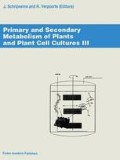Abstract
Several cell lines of Coptis japonica with different alkaloid productivities were characterized to obtain information on how a high metabolite production is established. High and low metabolite producing cells, except those from one cell line, showed similar growth kinetics and a similar pattern of nutrient uptake. Amino acid contents, especially that of tyrosine, differed between cell lines, but no correlation was found between the amino acid or tyrosine levels and alkaloid production. Since the addition of tyrosine did not increase the production of berberine, this primary substrate is apparently not the limiting factor for high production in cultured Coptis cells. The addition of berberine to the medium revealed that low-producing cells also have the ability to store alkaloid, and that low productivity is not due to decomposition of alkaloids which have been produced. The direct measurement of the biosynthesis of berberine using 14C-tyrosine clearly showed that high-producing cells had a higher biosynthetic activity of berberine from tyrosine than low-producing cells. The measurement of enzyme activities in berberine biosynthesis indicated that the early steps of berberine biosynthesis are important in the increased production of berberine.
Access this chapter
Tax calculation will be finalised at checkout
Purchases are for personal use only
Preview
Unable to display preview. Download preview PDF.
References
Bremner JM (1965) Inorganic forms of nitrogen. In: Black CA et al. (Eds.) Methods of Soil Analysis (pp. 1179–1237) Amer. Soc. Agron. Inc., Publ.
Ceriotti G & Spandrio L (1957) Colorimetric determination of tyrosine. Biochem. J. 66: 607–610
Conway EJ & Byrne A (1933) An absorption apparatus for the microdetermination of certain volatile substances I. The micro-determination of ammonia. Biochem. J. 27: 419–429
Dittrich H & Kutchan TM (1991) Molecular cloning, expression and induction of berberine bridge enzyme, an enzyme essential to the formation of benzophenanthridine alkaloids in the response of plants to pathogenic attack. Proc. Natl. Acad. Sci. USA. 88: 9969–9973
Frenzel T & Zenk MH (1990a) Purification and characterization of three isoforms of S-adenosyl-L-methionine:(R,S)-tetrahydrobenzylisoquinoline-N-methyltransferase from Berberis koetineana cell cultures. Phytochemistry 29: 3491–3497
Frenzel T & Zenk MH (1990b) S-Adenosyl-L-methionine: 3’ -hydroxy-N-methyl-(S)-coclaurine-4’ -O-methyltransferase, a regio- and stereoselective enzyme of the (S)-reticuline pathway. Phytochemistry 29: 3505–3511
Galneder E, Rueffer M, Wanner G, Tabata M & Zenk MH (1988) Alternative final steps in berberine biosynthesis in Coptis japonica cell cultures. Plant Cell Rep. 7:1–4
Linsmaier EM & Skoog F (1967) Organic growth factor requirements of tobacco tissue cultures. Physiol. Plant. 18: 100–127
Morris DL (1948) Quantitative determination of carbohydrates with Dreywood’s reagent. Science 107: 254–255
Muller MJ & Zenk MH (1992) The norcoclaurine pathway is operative in berberine biosynthesis in Coptis japonica. Planta Med. 58: 524–527
Muemmler S, Rueffer M, Nagakura N & Zenk MH (1985) Sadenosyl-L-methionine: (S)-scoulerine-9-O-methyltransferase, a high stereo- and regio-specific enzyme in tetrahydroprotoberberine biosynthesis. Plant Cell Rep. 4: 36–39
Murphy J & Riley JP (1962) A modified single solution method for the determination of phosphate in natural waters. Anal. Chim. Acta 27: 31–36
Rueffer M, Nagakura N & Zenk MH (1983) Partial purification and properties of S-adenosylmethionine: (R,S)-norlaudanosoline-6-O-methyltransferase from Argemone platyceras cell cultures. Planta Med. 49: 131–137
Sato F & Yamada Y (1984) High berberine-producing cultures of Coptis japonica cells. Phytochemistry 23: 281–285
Sato H, Taguchi G, Fukui H & Tabata M (1992) Role of malic acid in solubilizing excess berberine accumulating in vacuoles of Coptis japonica. Phytochemistry 31: 3451–3454
Sato F, Takeshita N, Fitchen JH, Fujiwara H & Yamada Y (1993) S-Adenosyl-L-methionine:scoulerine-9-O-methyltransferase from cultured Coptis japonica cells. Phytochemistry 32: 659–664
Stark DM, Timmerman KP, Barry GF, Preiss J &Kishore GM (1992) Regulation of the amount of starch in plant tissues by ADP glucose pyrophosphorylase. Science 258: 287–292
Steffens P, Nagakura N &Zenk MH (1984) The berberine bridge forming enzyme in tetrahydroprotoberberine biosynthesis. Tetrahedron Lett. 25: 951–952
Weatherburn MW (1967) Phenol-hypochlorite reaction for determination of ammonia. Anal. Chem. 39: 971–974
Yamada Y &Okada N (1985) Biotransformation of tetrahydrober-berine to berberine by enzymes prepared from cultured Coptis japonica cells. Phytochemistry 24: 63–65
Yamada Y &Sato F (1981) Production of berberine in cultured cells of Coptis japonica. Phytochemistry 20: 545–547
Yamamoto Y, Mizuguchi R &Yamada Y (1982) Selection of a high and stable pigment-producing strain in cultured Euphorbia millii cells. Theor. Appl. Genet. 61: 113–116
Yemm W &Cocking EC (1955) The determination of amino acids with ninhydrin. Analyst 80: 209–213
Yun D-J, Hashimoto T &Yamada Y (1992) Metabolic engineering of medicinal plants; Transgenic Atropa belladonna with an improved alkaloid composition. Proc. Natl. Acad. Sci. USA. 89: 11799–11803
Zenk MH, El-Shagi H, Arens H, Stöckigt J, Weiler EW &Deus B (1977) Formation of the indole alkaloids serpentine and ajmalicine in cell suspension cultures of Catharanthus roseus. In Barz W et al. (Eds.) Plant Tissue Culture and Its Biotechnological Applications (pp 27–43) Springer, Heidelberg
Author information
Authors and Affiliations
Editor information
Rights and permissions
Copyright information
© 1994 Springer Science+Business Media Dordrecht
About this chapter
Cite this chapter
Sato, F., Takeshihta, N., Fujiwara, H., Katagiri, Y., Huan, L., Yamada, Y. (1994). Characterization of Coptis japonica cells with different alkaloid productivities. In: Schripsema, J., Verpoorte, R. (eds) Primary and Secondary Metabolism of Plants and Cell Cultures III. Springer, Dordrecht. https://doi.org/10.1007/978-94-011-0237-7_20
Download citation
DOI: https://doi.org/10.1007/978-94-011-0237-7_20
Publisher Name: Springer, Dordrecht
Print ISBN: 978-94-010-4106-5
Online ISBN: 978-94-011-0237-7
eBook Packages: Springer Book Archive

